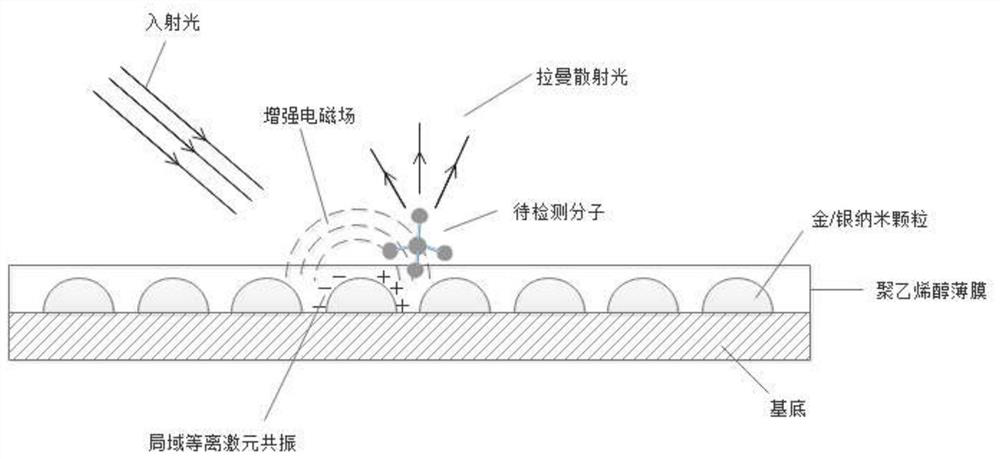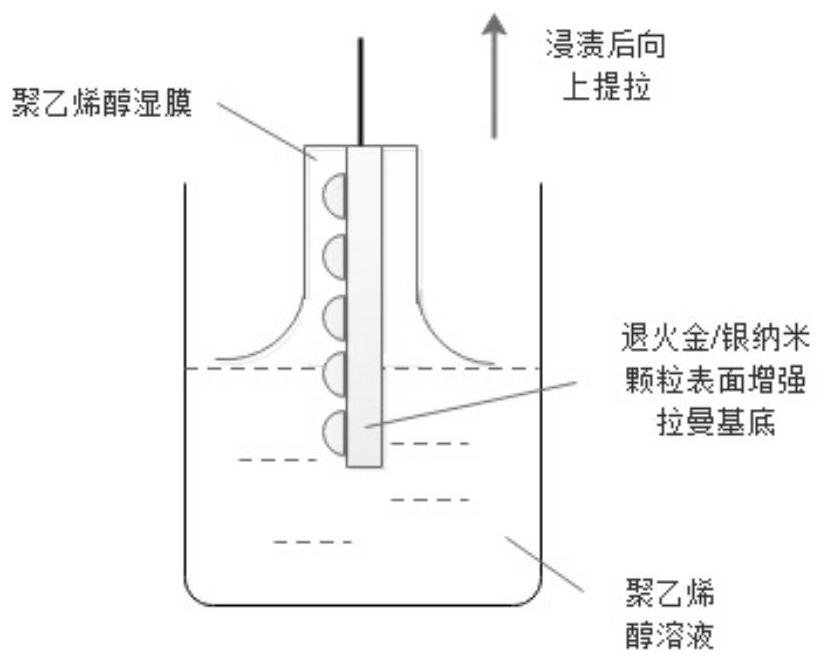Polyvinyl alcohol-coated surface-enhanced Raman scattering substrate and preparation method thereof
A surface-enhanced Raman and polyvinyl alcohol technology, applied in the field of materials, can solve the problems of lower detection limit, inability to quench fluorescence, and difficulty in adsorption
- Summary
- Abstract
- Description
- Claims
- Application Information
AI Technical Summary
Problems solved by technology
Method used
Image
Examples
Embodiment 1
[0046] like figure 2 As shown, the method of coating polyvinyl alcohol by dipping and pulling coating includes the following steps:
[0047] (1) Prepare a high-temperature-resistant SG3 high-purity quartz plate with a size of 10mm×10mm×1mm, ultrasonically clean it with alcohol and pure water for 10 minutes, and then dry it in an oven at 95 degrees Celsius.
[0048] (2) The quartz sheet is placed in an ion sputtering coating machine, and a silver film about 10 nanometers thick is sputtered on the quartz sheet.
[0049] (3) Place the quartz sheet sputtered with a silver film in a vacuum rapid annealing furnace, rapidly raise the temperature to 900 degrees Celsius at a rate of 25 degrees Celsius per second, and naturally cool down to room temperature (20 degrees Celsius) after keeping the temperature for 5 minutes, and take it out to obtain annealing Silver nanoparticles substrate.
[0050] (4) Weigh 0.5 g of polyvinyl alcohol, pour it into 300 ml of pure water, heat to 95 deg...
Embodiment 2
[0054] like figure 2 As shown, the method of coating polyvinyl alcohol by dipping and pulling coating includes the following steps:
[0055] (1) Prepare a high-temperature-resistant SG3 high-purity quartz plate with a size of 10mm×10mm×1mm, ultrasonically clean it with alcohol and pure water for 10 minutes, and then dry it in an oven at 95 degrees Celsius.
[0056] (2) The quartz sheet is placed in an ion sputtering coating machine, and a gold film about 5 nanometers thick is sputtered on the quartz sheet.
[0057] (3) Place the quartz plate sputtered with a gold film in a vacuum rapid annealing furnace, rapidly raise the temperature to 900 degrees Celsius at a rate of 25 degrees Celsius per second, and naturally cool down to room temperature (20 degrees Celsius) after keeping the temperature for 5 minutes, and take it out to obtain annealed Gold nanoparticle substrate.
[0058] (4) Weigh 0.5 g of polyvinyl alcohol, pour it into 300 ml of pure water, heat to 95 degrees Cels...
Embodiment 3
[0062] like image 3 As shown, the spin coating method is used to coat polyvinyl alcohol, including the following steps:
[0063] (1) Prepare a high-temperature-resistant silicon wafer with a size of 10mm×10mm×1mm, ultrasonically clean it with alcohol and pure water for 10 minutes, and then dry it in an oven at 95 degrees Celsius.
[0064] (2) The silicon wafer is placed in a magnetron sputtering coating machine, and a silver film about 10 nanometers thick is sputtered on the silicon wafer.
[0065] (3) Place the silicon wafer sputtered with a silver film in a vacuum rapid annealing furnace, rapidly raise the temperature to 900 degrees Celsius at a rate of 25 degrees Celsius per second, and naturally cool down to room temperature (20 degrees Celsius) after keeping the temperature for 5 minutes, and take it out to obtain annealing Silver nanoparticles substrate.
[0066] (4) Weigh 0.5 g of polyvinyl alcohol, pour it into 300 ml of pure water, heat to 95 degrees Celsius and co...
PUM
| Property | Measurement | Unit |
|---|---|---|
| thickness | aaaaa | aaaaa |
| particle diameter | aaaaa | aaaaa |
| particle diameter | aaaaa | aaaaa |
Abstract
Description
Claims
Application Information
 Login to View More
Login to View More - R&D Engineer
- R&D Manager
- IP Professional
- Industry Leading Data Capabilities
- Powerful AI technology
- Patent DNA Extraction
Browse by: Latest US Patents, China's latest patents, Technical Efficacy Thesaurus, Application Domain, Technology Topic, Popular Technical Reports.
© 2024 PatSnap. All rights reserved.Legal|Privacy policy|Modern Slavery Act Transparency Statement|Sitemap|About US| Contact US: help@patsnap.com










